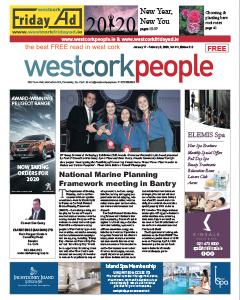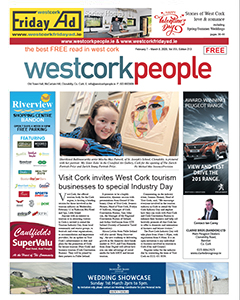Pádraig Whooley, IWDG Sightings Officer
Group of 4 humpback whales visit the MV Holly Jo off the Stags, near Toe Head. Pic: Daniela Morenstern, IWDG
It’s that time of the year when the rich inshore waters of West Cork come alive with marine wildlife and the Irish Whale and Dolphin Group (IWDG) gear up for a busy season of monitoring cetaceans (whales, dolphins and harbour porpoises) and basking sharks along our coastline.
The period April to June was once considered to be ‘low season’, as historically sightings and species diversity were lower at this time. This year however sees a continuation of a trend in recent years of Ireland’s smallest baleen whale, the minke whale, arriving as early as late March.
Soon after starting to write this piece, they were joined by the first humpback of the year on April 16, which on April 20 culminated in an incredible day out with Colin Barnes that produced no less than six humpback whales. At one stage, four of them approached the boat, which had its engines off, to investigate (see image). It was a remarkable experience for all on board. On this trip there were whale watchers from Germany who had been to Sri Lanka to watch blue whales and others who’d been to South Africa to watch Southern Right whales and they all agreed that none of their experiences in these tropical destinations came close to matching what they saw in West Cork.
At time of writing we can confirm the identity of five of these six humpback whales; they are numbers: HBIRL74, 79, 82, 83 & 87 and are known to IWDG researchers who curate the Irish Humpback Whale Catalogue, which has monitored this species in all Irish waters over the past 20 years. Such a high re-sight rate between years is noteworthy, as it reminds us that these are not random encounters, but that many of these individuals are feeding among cohorts that seek out the Irish Southwest year after year and in some cases decade after decade.
It’s difficult to know why whales are arriving earlier each year but the arrival of the spring equinox sees longer days and increased solar intensity and this, combined with storms mixing both man-made run off from the land and benthic sediment, provides the perfect conditions for a phytoplankton bloom later in spring, which kick starts the local marine food chain. At the top of which are the whales, who move in to take advantage of a local abundance of forage species such as sand eels now, and the all-important sprat and juvenile herring later in the year.
The earlier arrival of whales inshore is good news for whale enthusiasts and the burgeoning number of local boats now looking at taking up commercial whale watching as an alternative to more traditional marine tourism products, such as angling. All this is of course good news for local West Cork tourism, which is already attracting whale watch visitors from overseas. But there is something of a trade-off, as although we are finding minke and humpback whales earlier each year, the flip side is that our once late season peak in fin whales, which was such a boost to local B&Bs in October and November, seems to have become a thing of the past.
Increasingly disturbed weather in late Autumn/early winter is no doubt playing a part in this, but it’s also hard to rule out the impact that large, and in most cases locally owned, pair trawlers are having on sprat stocks in recent years, which have targeted this ecologically critical forage fish, at the very time they move inshore to spawn in our bays. Sprat are the favourite food of our biggest whale, the mighty fin whale, and it’s sad to report that they do seem to have switched allegiance to further east along the east Cork and Waterford coast, where there is less commercial fishing pressure on sprat. Our fin whales are voting with their fins.
For visitors who’d like to take advantage and try some whale watching, there are lots of land and boat based opportunities in West Cork, with established commercial whale watch operations at Reen Pier near Union Hall, Baltimore, Sherkin Island and a new operation now based in Courtmacsherry. Alternatively, and my personal favourite is to get out to one of West Cork’s headland vantage points with a good pair of binoculars and spotting scope on a calm, dry day; some notable sites would include: Old Head of Kinsale, Seven Heads, Galley Head, Toe Head, Baltimore Beacon, Cape Clear, Mizen Head, Sheep’s Head or Dursey Island (this list is not exhaustive). Remember, land-based whale watching is free, and is the only way to watch cetaceans without disturbing them and is also the only way you can guarantee you won’t get seasick!
For people who’d like to learn more about the cetaceans off West Cork, their ecology, conservation, current research and how to observe the different species that occur locally, IWDG as part of Biodiversity Week will be guiding a free, land- based watch at Cloghna Head, Rosscarbery Bay (between Long Strand and Ownahincha) on Saturday, May 25 from 6-8pm. No bookings necessary – just bring your binoculars and sense of humour. For further details email padraig.whooley@iwdg.ie or Phone 086-3850568.
We’d ask Citizen Scientists fortunate enough to see whales, dolphins or basking sharks at any time to report your observations to IWDG directly via the reporting section on www.iwdg.ie. Dead or live stranded cetaceans can also be reported to us. Your sightings are important and are a key monitoring tool that helps us track the movements of these magnificent mobile marine mammals as they pass along the West Cork coast.
Happy whale watching in the summer ahead.


